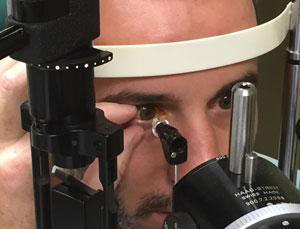 |
| In their findings, researchers discovered that central corneal thickness was increased in obese patients as well as patients with higher IOP, greater axial length and greater radius of corneal curvature. Photo: Natalie A. Townsend, OD, and John J. McSoley, OD. Click image to enlarge. |
There’s been extensive research into how overweight patients have a greater risk of developing glaucoma through the mechanism of increasing intraocular pressure, but until recently no meta-analysis had been conducted to observe the difference in average IOP in such patients compared to other weight classes. In a new meta-analysis intended to better understand the relationship between excess body weight and IOP, researchers from Indonesia compared and contrasted IOP values in patients at different body mass index values.
Out of 2,656 studies initially identified, the team analyzed nine studies that sampled a total of 22,920 patients. Each study focused on overweight patients (deemed the exposure group), normal-weight patients (controls) and their respective IOP values. From the nine studies, the researchers took the average IOP of each group in order to determine the mean difference. The study showed that the sample of patients with excess body weight had higher IOP values than normal-weight patients, with a mean IOP difference of 0.93mm Hg in favor of the exposure group.
In their paper on the findings, the researchers elaborated further by comparing the controls to three subgroups of the exposure. The mean difference in IOP gradually increased with heavier weight classes, as follows:
- Overweight subgroup = 0.60mm Hg higher
- Obese subgroup = 1.02mm Hg higher
- Morbidly obese subgroup = 1.25mm Hg higher
Two proposed concepts were used to explain why IOP is affected by excess body weight: the mechanical theory and the vascular theory. “Based on the mechanical theory, obesity can lead to an increase in IOP by causing an increase in intraorbital adipose tissue, blood viscosity and episcleral venous pressure, where fat accumulation in obesity leads to a decrease in aqueous humor outflow,” the researchers explained in the study. By contrast, the vascular theory “suggests that eyes with poor vascular supply to the optic nerve will be more susceptible to damage when having elevated IOP. Changes in autonomic and endothelial function can result in abnormal blood flow to the eye and unstable perfusion that impairs vascular supply.” Obesity was found to be a factor of vascular endothelial dysfunction and autonomic dysfunction, the authors explained.
Although the researchers nixed studies that categorized underweight patients as the exposure or control, one of the initial nine studies provided data on how these patients are more susceptible to primary open-angle glaucoma. The data showed that the risk ratio for glaucoma increased by 12.9% in underweight patients compared to normal-weight patients. The researchers concluded that patients with more or less body weight are at risk for open-angle glaucoma, but they did not differentiate the IOP values of overweight and underweight patients.
Since this meta-analysis focused on the effect of excess body weight, the researchers could not eliminate all other factors that influence IOP. Also, the studies examined were from various countries with differing definitions of BMI weight class. This was regarded as a limitation of the study. Furthermore, researchers noted that tools used to measure IOP differed among the nine studies, which could have potentially led to differences in reported values.
More research needs to be done to assess body weight’s direct effects on glaucoma, the authors acknowledge while emphasizing that it is now understood that excess body weight tends to lead to higher IOP and subsequent elevated risk of glaucoma.
Waspodo N, Giffari Makkaraka MA, Nislawati R, et al. Role of excessive weight in intraocular pressure: A systematic review and meta-analysis. BMJ Open Ophthalmology 2023;8:e001355. |

